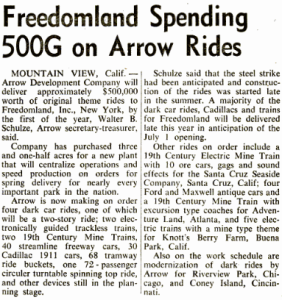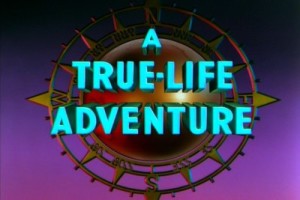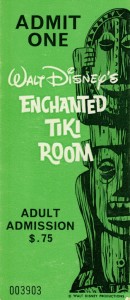Here Come The Answers – Part 2
by Todd J. Pierce
Generally I think that there are two types of online quizzes: ones where the questions are more enjoyable than the answers and others where the answers are more interesting than the prompts. This here, I believe, is the second type—an intriguing assortment of trivia and background. So pony on up to the computer screen. Pop open a diet Coke. Get ready to scroll and click. Ever heard of the knock-off Disney-style park in Denver, Colorado called Magic Mountain? No? Ok, here come the answers—part 2.
(6) The Alice attraction was the first dark ride built by Arrow Development that included this overall elevating feature?
OK, this question was hard. I’ll admit that. But really, did you want a quiz that included a question about the Laugh-O-Grams window in Toontown?
Here’s the short answer: The Alice attraction was the first two-story dark ride produced by Arrow Development.
And here’s the far more interesting long answer: In the early days of Disneyland, Walt Disney contracted out much of the ride system work to a little company in the Bay Area called Arrow Development. Before its connection with Disney, Arrow was producing mostly kiddie park rides, such as small-scale carousels and little boats. But the four-person team at Arrow stepped up to the challenge and developed ways to create ride vehicles that reflected the art direction of Disney designers. In 1955, Arrow Development contributed the vehicle design and ride systems for the original Mr. Toad and Snow White dark rides. They also created the engine for the Casey Jr. train; they designed and built the spinning teacup attraction; they developed the ride system for the Dumbo attraction; also they oversaw the installation of the Fantasyland carousel. But because Arrow Development was an outside company, the company then built similar ride and vehicle systems (based on the spinning cups, the flying elephants, and those used for the Disney dark rides) for other upstart theme parks. In 1958, Arrow developed a ride system that would support a two-story dark ride. Shortly after the two-story Alice attraction opened, Arrow began work on a two-story dark ride for a new theme park in New York called Freedomland. The use of the two-story dark ride system at Freedomland caused the Disney brothers to think long and hard about how they would use the very talented men at Arrow in the future. But that, of course, is a story for another day.
(7) As Walt poses with the Congo Queen, the background art features the final name of Adventureland—which of course is Adventureland? But what was the original name for Adventureland—a name that, in my opinion, makes far more sense?
True-Life Adventureland. That was the original name for the jungle-themed area of Disneyland—named after the popular and critically-successful series of Disney nature films, True Live Adventures. For my money, True-Life Adventureland does more firmly tie the area to the film series, which I like. But I admit, Adventureland does sound better.
(8) Since the mid-1950s, Disneyland used an alphabetical ticket system. First A,B, and C tickets—with D and then E later added. Trick question: what kind of ticket did the Tiki Room use when it first opened?
The Tiki Room, when it first opened, was priced separately from the alphabetical ticket system employed for most attractions. Adults paid 75 cents, kids paid 50 cents. But still, a bargain. An air-conditioned theater—a first for Disneyland. Cutting edge technology. And even a Jacques Offenbach number. (Hey, I’d easily shell out 75 cents to see that Offenbach number one more time.)
(9) In 1958—as Walt is standing front and center at the Golden Horseshoe Review—a team of ex-WED designers are building a theme park called Magic Mountain near Denver, Colorado which is largely inspired by Disneyland. Its plans include a not-so-original western saloon, complete with song-and-comedy show, whose name is almost identical to the Golden Horseshoe. Name it.
This question, here, relates to one of my favorite early-theme-park stories. In 1953 and 1954, Walt Disney hired dozens of art directors, architects, and engineers from other studios (most notably 20th Century Fox and MGM) to build Disneyland. In the 1950s, most studio artists worked on a project-to-project basis. So none of these people expected their jobs at Disney to last a lifetime. Most of them, in fact, were let go in 1955 or 1956, once the park was up and running—with a small remnant kept on to design new attractions in subsequent years. Many of these spurned art directors went on to design other theme parks that were, well, closely modeled on Disneyland. One of these parks—located just outside Denver—was called Magic Mountain. It, of course, had a main street area, a frontier fort, a proposed storybook land (which was never built), and a tomorrowland section (also never built). At Disneyland, the saloon where the western stage show was performed was named the Golden Horseshoe Saloon. In Colorado, it was the Golden Donkey Saloon. Anyone else think that this name was a little too close for comfort?
Want to know more? Here’s a great site to explore: http://www.goldenlandmarks.com/museum/magicmountain/layout.htm
(10) In December, 1958, Walt Disney holds a press conference to highlight three major new attractions for 1959: the subs, the monorail, and the Matterhorn. But earlier that same year, Disneyland sent out a press release announcing that they would build three major new attractions in 1959: the subs, the Matterhorn and one other attraction (which was not the monorail). What was the third major attraction originally announced for the 1959 expansion?
The big three for 1959, of course, were the Matterhorn, the monorail, and the Submarine Voyage. But back in 1958, Walt Disney had announced that a Ghost House (an early walk-through version of the Haunted Mansion) would be among those attractions opening the following June. For months, the Haunted Mansion was actively planned for 1959, with art direction largely overseen by Disney artist, Ken Anderson. The Mansion, of course, did not open in 1959. Nor in 1960. It was continually developed and re-developed over the following decade, with at least two major overhauls to its basic narrative. In 1969 (over 11 years after it was initially announced to the public) the Mansion would finally open. Though I could be wrong—as I sit here typing this—I can’t think of any other attraction at Disneyland that would open 10 years late, can you?
If you enjoyed the quiz, sound off below or at the DHI Facebook page.
I’ll be back later this week with a high-flying, never-before-published-photo of Walt.
Todd J. Pierce






Recent Comments